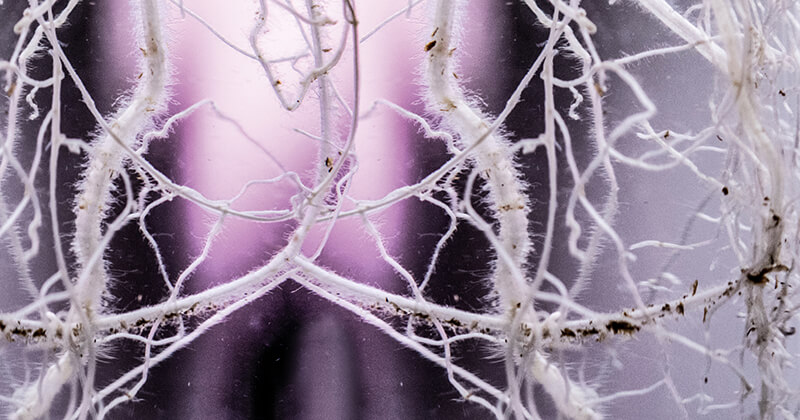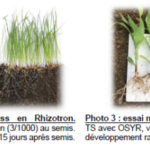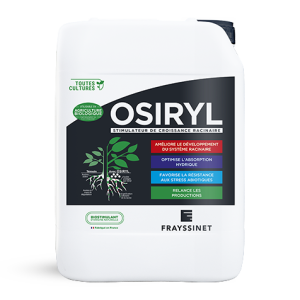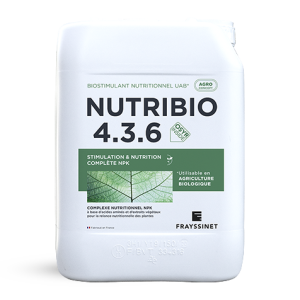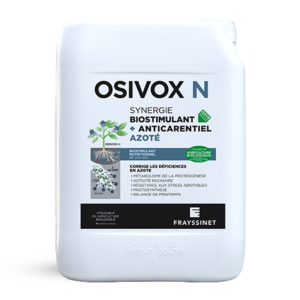Biostimulation
Understanding biostimulation
Biostimulation
In its etymological sense, a biostimulant is a product that “stimulates living organisms”.
Biostimulants represent a new category of products that has been developed for several decades. Based on its expertise in its plant research programmes since the 1990s, Frayssinet was one of the first companies to market a biostimulant.
Today, among the great variety of claims put forward (growth stimulators, soil activators, biofertilisers or phytostimulants…) and the origins (plant extracts, biomolecules, silica, humic acids…), the range of solutions is varied.
The mechanism by which plants adapt to stress
Understanding plant biostimulation means first and foremost understanding how a plant functions and how it perceives and interacts with its environment.
The function of biostimulants is to support the physiological processes of plants by acting on well-known metabolic pathways during their growing cycle, protecting them from the impact of abiotic stresses.
The 3 key stages in the plant’s reaction “when faced with danger” are :
> Perception: recognition by specific membrane receptors of the “non-self” (DAMP/MAMP1), which leads to the identification of the stress, of the “abnormal” condition or danger.
> Signal transduction: i.e. the dissemination of the information within the plant. This takes place from cell to cell via a flow of calcium.
> The cellular response through the expression of resistance genes, signals and regulation of hormonal status, enabling induced local resistance. Basic resistance metabolic processes and/or an adaptive responses are then activated via an integrative system (reactive oxygen species (ROS) / phytohormones).
Activation of the cellular response is counterbalanced by enzymatic detoxification systems or antioxidant compounds. In the event of excessive stress or danger, the defence systems can go as far as the destruction of the cell.
1 Damage Associated Molecular Patterns/Microbe-associated Molecula Patterns
Biostimulants help to maximise genetic potential and maintain activity during periods of stress, thereby securing yields. If climatic conditions are favourable, biostimulants will have a minor effect. Since periods of stress are unpredictable, biostimulants should be seen as insurance against climatic ups and downs.
Soil biostimulation
In the definition of biostimulants in the latest EU regulation, the notion of “availability of nutrients confined in the soil or rhizosphere” appears. Some products can be classified as biostimulants by acting indirectly on one of the components of the soil to release or help fetch nutrients. In this way, by optimising the resource available, this type of biostimulant also improves plant function. Soil biostimulants only work if the soil contains organic matter and nutrients.
Two main modes of action are expected: activation of telluric or rhizospheric flora and release and provision of nutrients.
Getting to market
Definition
The European Commission defines biostimulants as a product that stimulates the plant nutrition process independently of the nutrients it contains, with the sole aim of improving one or more of the following characteristics of plants or their rhizosphere:
> the efficiency with which nutritional elements (N, P, K, Mg, Ca, etc.) are used;
> the availability of nutrients confined in the soil or rhizosphere;
> resistance to abiotic stresses (low temperatures, water stress, salinity, etc.);
> crop and harvest quality.
Biostimulants can be natural substances (biomolecules, plant and algae extracts, micro-organisms), mineral substances or even synthetic, non-nutritive molecules acting to improve the physiological metabolism of crops, by application to plants or the soil.
More than their constituents or their nature, it is their mechanisms of action and their claims that will define them.
Regulatory context for biostimulants
In France, biostimulants are part of the MFSC (Matières Fertilisantes et Supports de Culture) family. Biostimulants do not have the same application standards as soil improvers, fertilisers or growing media. In order to be placed on the market, all biostimulant products be approved beforehand and obtain a Marketing Authorisation (MA).
The E-phy website, managed by ANSES, can be used to check whether a biostimulant has a marketing authorisation, its claims and its uses.
There are three ways of obtaining a marketing authorisation in France:
> a national approval process under the supervision of ANSES, which checks the efficacy of the solution (significant trials on each authorised use), the mode of action and a toxicological assessment.
> a national mutual recognition process in compliance with European rules. The applicant must demonstrate to the national authorities that the product is marketed as a biostimulant in another EU country. The assessment is purely documentary, with no verification of efficacy or toxicity.
> A European assessment and registration process under regulation 2019/1009 with an efficacy dossier and proof of absence of contaminants (TMEs, contaminants, pathogens).
Once approval has been obtained, and provided the marketing authorisation expressly states “authorised as an agronomic additive”, biostimulants may be marketed mixed with crop supports or fertilising materials in accordance with authorised French standards (NF U 44-551/A4 and NF U44-204).
Biostimulants and organic fertilisation: the winning synergy
Choosing the right biostimulant
Why use a biostimulant
Biostimulants are products that provide new leverage for crops; they are not a substitute for other existing techniques.
The use of a biostimulant should provide a response to a problem that depends on the production system implemented (crop, soil, climate, the farmer’s practices, etc.). The real question is:”What is my problem? For example: root establishment problems, resistance to water stress, biological activation of soils, nutrient assimilation problems.
A biostimulant must be part of an optimised, comprehensive nutrition and protection programme. There are two important elements in the concept of such a programme:
1. Management: positioning must be based on weather data and anticipation of future stresses. The use of Decision Support Tools (DST) is a plus.
2. Interactions between products. In addition to physical interactions (mixing in the tank), we need to look at metabolic interactions and how the plant reacts
.
How to choose
Users must consider the properties of each solution (claims, registered crops and conditions of use) in order to select the one that best suits their needs. These claims and modes of action are stipulated in the marketing authorisation and must therefore appear on the label.
The conditions of application must be assessed: humidity, temperature, etc. Each product may have its own specific characteristics. For live products applied to the soil, you need to be sure that the strain is suitable (in particular pH and OM levels).
Biostimulant or defence stimulator
Biostimulants and defence stimulators (SDPs) each belong to a different regulatory framework. Biostimulants are classified as fertilisers and growing media (MFSC), while SDPs are considered as plant protection products (PPP).
Biostimulants act on abiotic stresses (climate, mineral element deficiency, etc.), while plant defence stimulators act on crop protective mechanisms in the face of biotic stresses (diseases or pests). SDPs have a specific activity of inducing plant defence reactions.
A biostimulant that can be used in organic farming?
Be careful when mixing. Biostimulants do not necessarily comply with organic farming regulations. The extraction or production methods used may be contrary to the principles of organic farming.
Osyr: active ingredient to stimulate root growth
Frayssinet’s research into soil organic matter has made it possible to isolate organic molecules of natural origin that act to stimulate plant metabolism. These include OSYR.
OSYR is the active ingredient in the product branded OSIRYL, the first root growth stimulator authorised in France (AMM 1030003) registered on the lists of products that can be used in organic farming. Obtained by depolymerising lignocellulosic compounds, OSYR generates a synergy of resistance and root system boosting actions.
The origin of the OSYR active ingredient
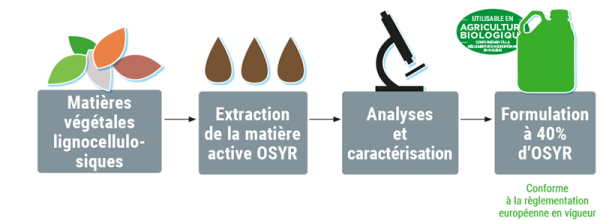
Action mode
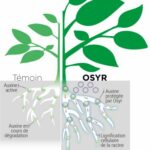 |
OSYR stimulates plant growth and root regeneration through two actions: – by protecting auxins from oxidative mechanisms – by strengthening root resistance in stressful conditions. In situations of stress and nutritional deficiency, the auxins involved in plant physiology (reproduction, growth, flowering, rhizogenesis, etc.) are degraded. This auxin degradation has a negative impact on reproductive mechanisms and crop quality. OSYR has the ability to protect these natural auxins, enabling balanced crop development and resistance to environmental stress. OSYR has a natural origin, and the activity of its active ingredient is independent of agro-pedo-climatic conditions, giving it constant and regular efficacy. |
Test results
The Frayssinet research centre has carried out numerous studies under controlled conditions to characterise the activity of the active ingredient OSYR on vines, arboriculture, market gardening and field seeds.
Field crops
|
– Improves the emergence and uniformity of seedlings at first growth test results FC
|
|
|
– Stimulates and promotes root development in plants The application of OSYR by seed treatment shows a significant increase in the root system both under controlled conditions and in field trials. test results FC
|
|
Vine
|
– Planting Winegrower – Cénac (33) – Merlot
|
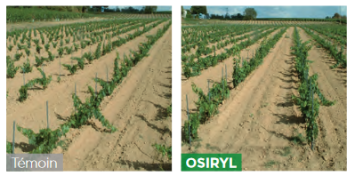 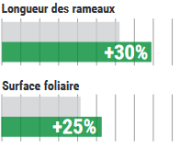 |
|
– Stressful condition Winegrower – Chouilly (51) – Chardonnay
|
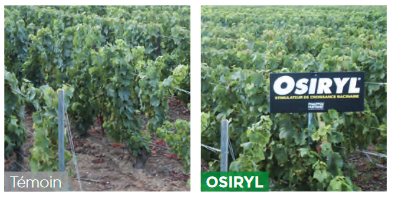 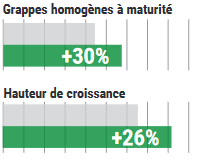 |
Arboriculture
|
– Apple trees in planting site Arborist – Sainte-Bazeille (47) – Brookfield on PAJAM1 and Chantecler on NAKB Osiryl at 20 L/ha has a significant effect on the development of lateral shoots. The applications show a dose effect: on the Brookfield variety, the number of lateral shoots is doubled (+48%) at the dose of 40 L/ha and the general growth of the trees is significantly higher (+15% trunk diameter and +14% terminal shoot length) compared with the untreated controls.
|
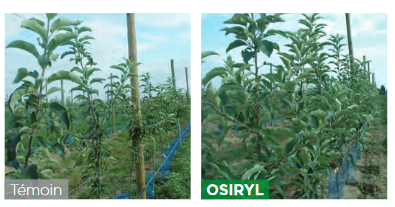 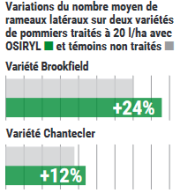 |
Market gardening
|
– Lettuce production Market gardener – Béziers (34) – Batavia blonde
|
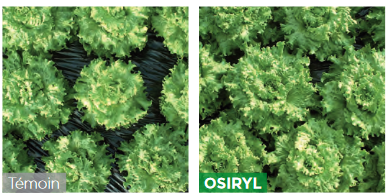 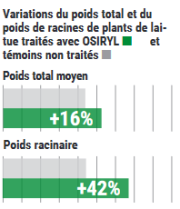 |
|
– Melons under stress University – Montpellier (34) – Luna
|
  |
Find out more about OSYR in specialised crops



